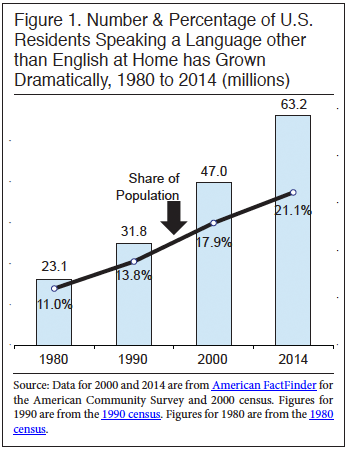Illegal, asylum, refugees, entitlements, protected class, surrendered
Record 63.2 million non-English speaking residents, surge in Arabic, Chinese, Spanish
By Paul Bedard
More than one in five U.S. residents speak a language other than English at home, a record, according to the U.S. Census Bureau.
In an analysis of the recent Census American Community Survey, a huge surge was recorded in those who speak Chinese, Spanish, Arabic and Urdu, Pakistan’s national language.
The report from the Center for Immigration Studies documented the growth of immigrants in the United States and provided evidence of concerns new immigrants are slow to assimilate into American culture, namely by speaking English at home.
According to the Center’s analysis released to Secrets Tuesday morning, in 2014, a record 63.2 million U.S. residents — native-born, legal immigrants, and illegal immigrants — spoke a language other than English at home. That represents a surge of 16.2 million since 2000 and 1.4 million just since 2013.

Overall, wrote the Center’s Steven A. Camarota and Karen Zeigler, the number of non-English speakers has doubled since 1990.
The top findings in the report titled “One in Five U.S. Residents Speaks Foreign Language at Home:”
- Since 1990 the number of foreign language speakers has roughly doubled; the number has almost tripled since 1980.
- In 2014, a record 63.2 million U.S. residents (native-born, legal immigrants, and illegal immigrants) spoke a language other than English at home. That number is up 16.2 million since 2000, up 3.6 million since 2010, and up 1.4 million just since 2013.
- Taking a longer view, since 1990 the number of foreign language speakers has roughly doubled.
- As a share of the population, 21 percent of U.S. residents speak a foreign language at home.
- The largest percentage increases from 2010 to 2014 were among speakers of Arabic (up 29 percent), Urdu (up 23 percent), Hindi (up 19 percent), Chinese and Hmong (both up 12 percent), and Gujarati and Persian (both up 9 percent). Urdu is spoken in Pakistan; Hindi and Guajarati are languages of India; Hmong is spoken in Laos; Persian is spoken in Iran.
- The largest numerical increases from 2010 to 2014 were among speakers of Spanish (up 2.3 million), Chinese (up 331,000), Arabic (up 252,000), Tagalog (up 115,000), Hindi (up 114,000), and Urdu (up 89,000). Tagalog is spoken in the Philippines.
- Languages with more than a million speakers in 2014 were Spanish (39. 3 million), Chinese (3.1 million), Tagalog (1.7 million), Vietnamese (1.5 million), French (1.2 million), and Korean and Arabic (1.1 million each).
- Of school-age children (five to 17), 22 percent speak a foreign language at home.
- Many of those who speak a foreign language at home are not immigrants. Of the more than 63 million foreign language speakers, 44 percent (27.7 million) were actually born in the United States.
- Of those who speak a foreign language at home, 25.6 million (41 percent) told the Census Bureau that they speak English less than very well.
One last item, the terror component:
Reuters: FBI counterterrorism investigators followed “dozens and dozens” of potential militants around the United States full time during the summer and “disrupted” many of them, FBI Director James Comey told a congressional committee on Thursday.
Comey, who testified before the Senate Committee on Homeland Security and Governmental Affairs along with Nick Rasmussen, director of the National Counterterrorism Center, said U.S. investigators are aware of dozens of U.S.-based Islamic militant suspects who now are using encrypted communications.
Comey said investigators had followed “dozens and dozens of people around the United States 24/7” during the summer and had “disrupted” them.
Comey told the committee that Islamic State recruits from the United States are incrementally younger with more “girls –women under 18” – seeking to join the militant group.
Rasmussen testified that Islamic State has overtaken al Qaeda as leader of the global violent extremist movement and has access to a large pool of potential recruits in Western countries.
He said counterterrorism experts still regard al Qaeda’s Yemen-based affiliate AQAP as big threat due to its interest in attacking the United States and airplanes.
